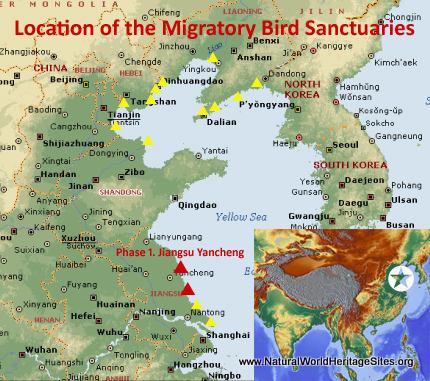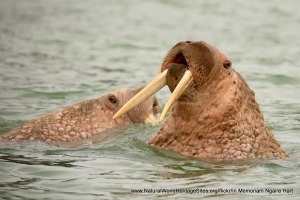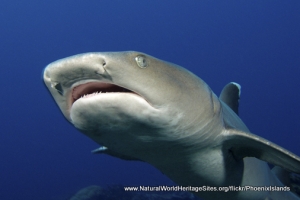EXPLORE the Migratory Bird Sanctuaries along the coast of Yellow Sea-Bohai Gulf of China with this slideshow, check the location map and get all the facts and information below.
For slideshow description see right or scroll down (mobile). Click to view slideshow
Location and Values: The Migratory Bird Sanctuaries along the coast of the Yellow Sea-Bohai Gulf of China are located along China’s eastern Yellow Sea coast, stretching northward from the Yangtze River mouth at Shanghai to the country’s southernmost border with North Korea. This area of shallow sea is bounded by the world’s most extensive intertidal mudflat system, which serves as a feeding and resting area for vast numbers of migratory birds using the East Asian-Australasian Flyway. The first phase of the world heritage listing includes two separate sites in Jiangsu Province (centred on Dafeng and Yancheng National Nature Reserves) while a further 14 sites around the gulf will be added subsequently. The configuration of this serial site will eventually span a distance of 1,000 km from the mouth of the Yangtze to the northern margins of the Gulf of Bohai.
From a global conservation perspective, the site represents an irreplaceable hub along the East Asia-Australasia Flyway, linking bird populations between at least 21 countries. The site provides critical habitat for 415 species of birds, including 17 rare and endangered species on IUCN’s Red List. Five of these species, in particular, are fully dependant on the site for their survival, namely the spoon-billed sandpiper, Nordmann’s greenshank, great knot, Far Eastern curlew and Chinese crested tern.
Conservation Status and Prospects. According to IUCN’s Conservation Outlook Assessment (2020) the conservation status of the Migratory Bird Sanctuaries along the coast of the Yellow Sea-Bohai Gulf of China is of ‘significant concern’. The IUCN report notes that the Chinese part of the coast of the Yellow Sea has been subject to an extraordinary transformation over the last few decades as natural habitats have been lost to land reclamation for industrial projects, farming, aquaculture, industry, leisure and wind power development. The marine environment has been affected by the development of large port facilities and associated heavy marine traffic. While the intended network of sanctuaries will make an important contribution to sustaining migratory bird populations, habitat alterations elsewhere within the Yellow Sea and beyond are likely to have a profound impact in the long term unless they can be effectively mitigated. The IUCN report emphasizes the need to develop and manage the various components of the world heritage site within the context of a much broader conservation effort focused on habitat restoration involving cross-sectoral, inter-regional and trans-boundary cooperation.
Links:
Google Earth
Official UNESCO Site Details
IUCN Conservation Outlook
Birdlife IBA
Slideshow description
The slideshow ‘tells the story’ of the Migratory Bird Sanctuaries along the coast of Yellow Sea-Bohai Gulf of China with a portfolio of photos that illustrate the main habitat features, bird congregations and important species from the area. It covers the two existing components of the site as well as photos from places that have been identified for future extension, including the Phragmites reedbeds of Caofeidan wetland (Hubei Province, component 10), the mudflats of Dangong Wetlands (Liaoning Province, component 1) and the stunning pink expanses of halophytic marshland plants that characterize the Liaohe River Estuary (Liaoning Province, component 5). The bird species featured in the slideshow include, amongst others: relict gull, swan goose, Baillon’s crake, Oriental stork, Noordman’s greenshank, red knot, avocet, bar-tailed godwit, black-bellied and grey plover, great knot, Chinese crested tern, black-faced spoonbill, and red-crowned crane.
The following Flickr photographers and other sources are acknowledged with thanks for their contributions to this slideshow (as credited in the watermark of each photo): Jackie, Neil Fifer, Adam Rainoff, Andrew Hardcastle, Jeschen, Volker Kull, Mukwan, Ged Tranter, tinyfishy, Tien Chu Chang, 57Andrew, Priscilla Sze, The Paulson Institute, Tony Gray, The Paulson Institute/Gerrit Vyn and The Paulson Institute/Wang Jianmin. Note that some of the close-up photos are from other locations along the flyway, and these are included for illustrative purposes, as representatives of the species found in the area.
Factfile
Website Category:
Marine & Coastal
Area: (Phase 1) 1,886 km2
Inscribed: 2019
UNESCO Criteria:
- Natural habitat for biodiversity (x);
- Significant number of rare, endemic and/or endangered species (x)





